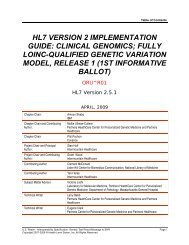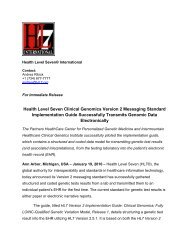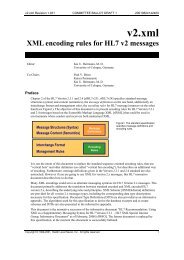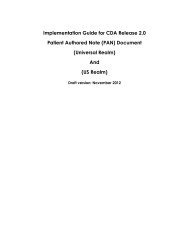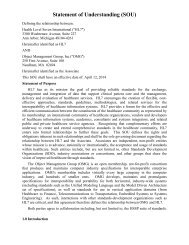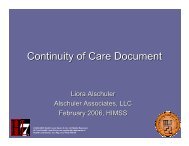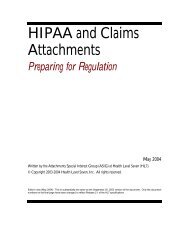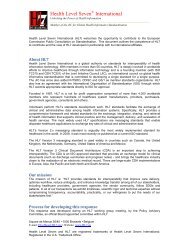HL7 CDA R2 AIS Implementation Guide
HL7 CDA R2 AIS Implementation Guide
HL7 CDA R2 AIS Implementation Guide
You also want an ePaper? Increase the reach of your titles
YUMPU automatically turns print PDFs into web optimized ePapers that Google loves.
<strong>HL7</strong> Additional Information Specification <strong>Implementation</strong> <strong>Guide</strong><strong>CDA</strong><strong>R2</strong><strong>AIS</strong>0000R0303.7.16.2.1 Periodic administrationThe second element may be of type PIVL_TS or EIVL_TS to indicate theperiodic timings for specific administrations. It shall have the @operator attribute set to "A".(The @operator attribute is described in the <strong>HL7</strong> v3 Data Types specification; "A" means "formthe intersection with the values".) If no second element is present, then theadministration is assumed to be continuous over the time span indicated by the first element.The example below shows how periodic time interval is recorded.The above example shows a periodic interval of every eight hours for 10 minutes, in phase with astart time of 08:00am.The element describes the time between administrations. Units may be specified inseconds, minutes, hours, days, weeks, months, lunar months, using the values shown in Table3.7-2.Table 3.7-2 Units for Time PeriodsUnit code Meaningssecondsmin minuteshhoursddayswk weeksmo monthsmo_s Lunar monthsIf the administration is to be started at a specific time, then the starting time shall be specified in element of the element. The element is a time stamp (TS data type) thatindicates when the first dose should start. If that time is unknown, the element shall beomitted.If the administration is to occur for a specific duration, this shall be recorded in the element of the element. The is a PQ data type. The @value attribute must bepresent, and indicates the duration, and the @unit attribute is the unit of time. The @unitattribute must also be present, and contain one of the unit codes shown in Table 3.7-2.It is also common to indicate the number of dosages per day. These are represented byconverting the number of dosages per day into the number of hours between dosages, and settingthe value of the @institutionSpecified attribute to true. Thus, BID (twice a day), is represented asevery 12 hours at institution specified times. When the @institutionSpecified attribute is true, the element of the element should not be sent.Copyright © 1998-2007 Health Level Seven, Inc. All rights reserved.Release 3.0 Draft StandardPage 67March 2007




